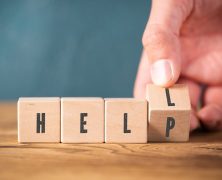What the hell happened to help?
What is banking? At its most basic, it is the movement of numbers from one spreadsheet cell to another – done securely. Obviously, the spreadsheet is a ledger, and the numbers represent value and value exchange between parties, be they individuals, organisations or institutions.

Banks should step up to provide financial education, guidance and advice
From simple beginnings, banking has become more and more complex over time. From ancient Babylonia in 2000 BC, where interest was paid on gold deposits, to the emergence of modern banking in the 17th century when the Bank of England issued banknotes, to the “Big Bang” in London when retail banks started acquiring investment banks, to the wonderful world of crypto.
The mere mention of a spreadsheet suggests that banking has a mathematical underbelly, and we know that not everybody is good at math. So, sitting on top of these ledgers are people to help make sense of the complexity. Inventors of products and services and, importantly, the industry’s human face – finding, nurturing and managing relationships. In good times and bad.
In personal banking, it was the bank manager who sat at the heart of this relationship. But the last 20 years has seen them slowly drop the mic and disappear.
Through digitisation, banks have shifted their customer strategy from relationship to transactional, with customers using desktop and mobile applications to manage their underlying spreadsheets. But it didn’t need to be like that!
Many years ago, I worked with an incredible lady – Roberta Arena. Roberta was head of e-business at HSBC. Roberta was an unfathomably smart, straight-talking New Yorker. We worked with her and her team on developing the bank’s first proper post-dotcom digital strategy.
Roberta had a framework she talked to us about which has stuck with me and acted as my spirit guide over the years. She spoke about digital in terms of “Do it Yourself” or “Do it With Me”. The idea is that the two main facets of digital were self-service or guided activities, the “Me” being the bank.
The sad reality is that, in a rush for a cost-focused digital transformation, “Do it With Me” was never prioritised.
My “kitchen table” research suggests that many people don’t know who to turn to for guidance or help to make sense of finance. They feel overwhelmed, lost and often stupid. They think they should know the answers. But usually they don’t even know what questions they should be asking (opportunity klaxon).
Plus, there is a massive reluctance to talk about money in family units, which further compounds the issue.
And don’t get me started on the lack of education in schools. One group we interviewed in their 20’s told me the extent of their school-based finance education was how to write a cheque – useful! Helping fix basic financial education needs addressing, not only by the likes of St James’s Place and NatWest, but also by governments.
This is a real problem. And an opportunity…
In the blue corner, plugging this knowledge gap, are the ‘finfluencers’, who are gaining traction thanks to the reach of social media. Many of them are not qualified financial advisors, but they are great at packaging advice and promoting it online.
Take Patricia Bright as an example. Patricia has 2.88 million subscribers to her YouTube channel. She offers frank, practical advice across a range of personal finance topics. Or Ali Abdaal, who offers investment guidance. One of his recent videos on investment got 1.4 million views. And just a few weeks ago, my 20-something daughter asked me if she should invest in Cardano. I asked why – a TikTok influencer was promoting it, obvs!
Of course, some of this content is awful, and it’s the awful and dangerous advice that is problematic. Just last week, TikTok clamped down and added financial services, including crypto and pyramid schemes, to the list of promotional content it has banned. They have also issued a warning to users against taking advice based on TikTok videos.
So, in the red corner, the opportunity is there for banks to step up and leverage their audience, infrastructure, platforms and qualified experts to provide financial education, guidance and advice that their customers and potential customers desperately need.
Social platforms have demonstrated the potential (and the pitfalls), banks now need to recognise social as a force for good and leverage it to deliver Roberta’s “Do it With Me” experiences.
A great place to start is to look at what exists. Look at who is being successful and try to understand why. Look, learn and then use your imagination to make it happen.
About the author
 Dave Wallace is a user experience and marketing professional who has spent the last 25 years helping financial services companies design, launch and evolve digital customer experiences.
Dave Wallace is a user experience and marketing professional who has spent the last 25 years helping financial services companies design, launch and evolve digital customer experiences.
He is a passionate customer advocate and champion and a successful entrepreneur.
Follow him on Twitter at @davejvwallace and connect with him on LinkedIn.











































